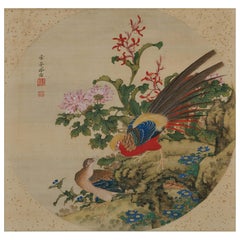Yoshizawa Setsuan
Antique Mid-19th Century Asian Meiji Paintings and Screens
Silk
People Also Browsed
Antique 18th Century Chinese Other Textiles
Silk
Antique Early 19th Century Japanese Edo Paintings and Screens
Gold Leaf
20th Century Japanese Showa Paintings and Screens
Brass
Antique Mid-19th Century Asian Edo Paintings and Screens
Silk
20th Century Japanese Meiji Paintings and Screens
Brass
Antique 1840s Japanese Edo Paintings and Screens
Silk
Antique Mid-19th Century Asian Edo Paintings and Screens
Silk
Early 20th Century Japanese Showa Paintings and Screens
Silk, Wood, Paper
Antique Late 17th Century Japanese Japonisme Paintings and Screens
Wood, Paper
Antique 1670s Japanese Edo Paintings and Screens
Gold Leaf
Antique Mid-19th Century Japanese Edo Paintings and Screens
Silver Leaf
Antique Late 18th Century Japanese Paintings and Screens
Gold, Gold Leaf
Antique Early 18th Century Japanese Edo Paintings and Screens
Gold Leaf
Early 20th Century Japanese Taisho Paintings and Screens
Silk
Antique Mid-19th Century Asian Edo Paintings and Screens
Silk
Antique Mid-19th Century Asian Edo Paintings and Screens
Silk
A Close Look at meiji Furniture
From 1868 to 1912, Emperor Mutsuhito oversaw an era of transformation in Japan. Formerly a country of feudalism and isolation, Japan entered an age of modernization influenced by newly established trade and exchange with the West. The Meiji period, or period of “enlightened rule,” also saw the global impact of the East Asian country’s culture. Japanese Meiji furniture was exhibited at expositions from Paris to San Francisco and created for export.
Prior to the Meiji era, furniture was mostly made by commission for the ruling class; now there were new domestic and international markets. European styles like Japonisme appropriated Japanese design while craftsmen in places like Wales and England employed japanning, a varnishing technique that approximated the appearance of lacquer for the surfaces of furnishings.
Meiji furniture made for Japanese homes and buildings constructed in Western styles resulted in taller tables, chairs, cabinets with large drawers and other features. The government invested in areas such as transportation and communication, and because people could freely choose occupations after the restrictions of feudalism, industries of various types were energized by expressive new ideas during those years. Art schools were formed and, for the first time, design was an area of study in the country, leading to the evolution of professional design as a career by the 1890s.
The work of Japanese designers was transmitted widely through lavishly illustrated pattern books that included designs for screens and lacquerware for the home. While screens today may be of use as decorative accents or partitions to ensure privacy in one’s space, Japanese screens were adorned with paintings and were featured in performing arts such as concerts, tea ceremonies and more. The color illustrations that characterize Meiji woodblock prints, a genre of Japanese art that grew out of 17th-century developments in printing and book publishing, depicted the sweeping changes that the era brought to East Asia.
Although it was a time of societal and cultural shifts, a bolstered interest in art and design elevated Japanese craft traditions. From colorful porcelain table lamps with silk shades and hardwood tables decorated with dark lacquer to cabinets featuring iron hardware and inlaid with mother-of-pearl, Meiji furniture showcased Japan’s artistic heritage to the world.
Find a collection of antique Japanese Meiji period case pieces and storage cabinets, decorative objects, wall decorations and more furniture on 1stDibs.
Finding the Right paintings-screens for You
Traditional Asian paintings were often created on scrolls and folding screens. Artisans made screens that could be folded up or spread out by connecting several panels using hinges. Today, antique Asian folding screens and paintings are sophisticated decorative accents that can serve as makeshift partitions to ensure privacy.
The original folding screens were created by Chinese artists. The earliest record of screens comes from the 2nd century B.C., and surviving examples date back to the Ming dynasty. Chinese painting utilizes many of the same tools as calligraphy — these screens were crafted from wood with painted panels featuring striking art or calligraphy that told cultural stories or represented nature and life in the area.
The practice was introduced to Japan, where paintings for screens were made on paper and silk, in the 8th century. These paintings frequently feature subjects such as landscapes, animals, flowers and Buddhist religious themes. Along with screens for tea ceremonies and dance backgrounds, there were screens for use in Shinto and Buddhist temples.
In the 17th century, screens began to be imported to Europe where their popularity grew. Coco Chanel famously collected Coromandel folding screens.
Traditional Asian paintings can make a tasteful addition to any wall, and screens can be used as decoration or, in the case of larger iterations, as an aesthetic way to divide a large room. Browse the selection of antique Asian paintings and screens from a variety of styles and eras on 1stDibs.


